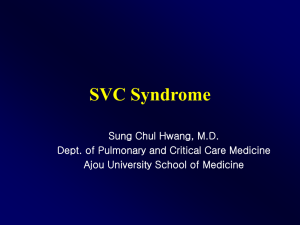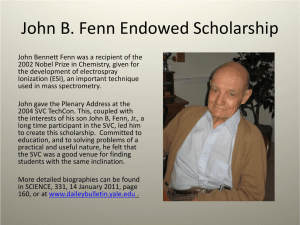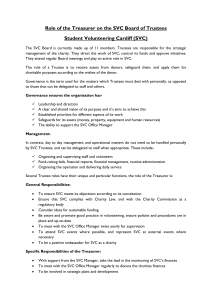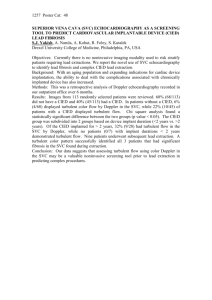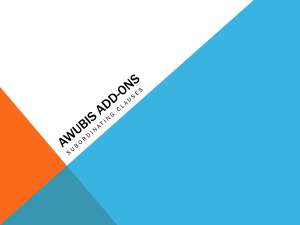Identifying, Using, and Punctuating Basic Sentence Patterns
advertisement
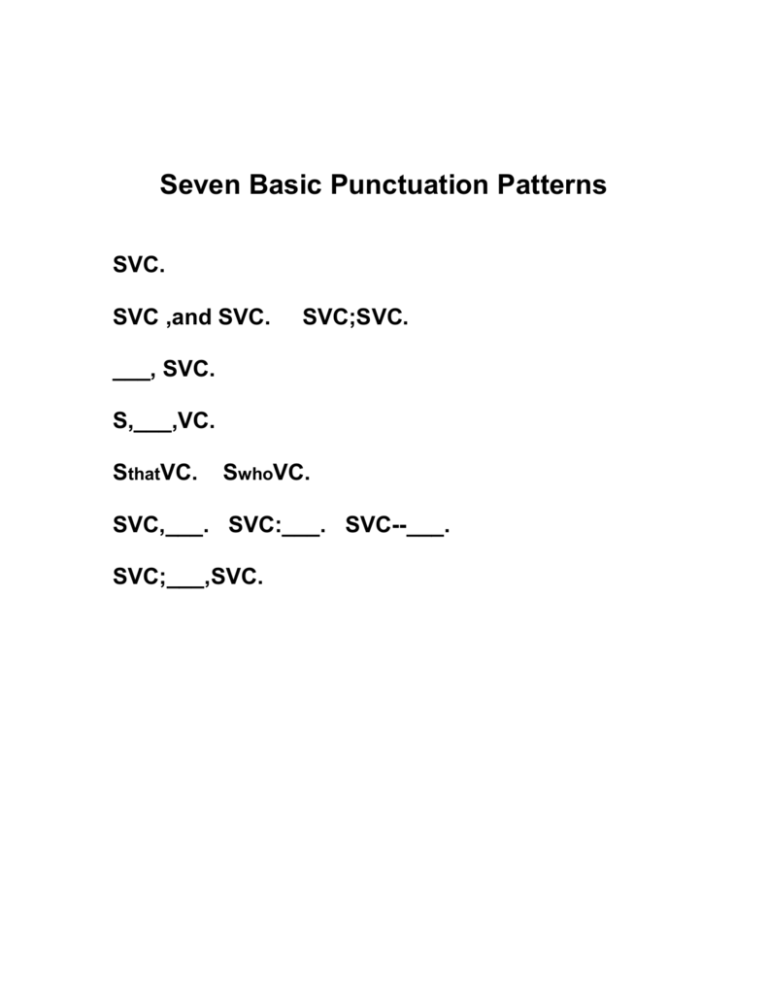
Seven Basic Punctuation Patterns SVC. SVC ,and SVC. SVC;SVC. ___, SVC. S,___,VC. SthatVC. SwhoVC. SVC,___. SVC:___. SVC--___. SVC;___,SVC. Identifying, Using, and Punctuating Basic Sentence Patterns The following patterns are the most common ones in written American English. Each sentence pattern contains an independent clause that can be a complete sentence. The independent clause (SVC.) contains a subject (S), a verb (V), and a completer (C),. The completer = any word or words that complete the thought. Subject Verb Completer The man in the gray suit ran to get out of the rain. My youngest brother is a very good guitar player. Most of the patterns contain additional words, phrases, or subordinate clauses that attach to the main SVC. Phrases are word groups that function within the sentence. (See the list of phrases in Pattern #3 below): Subordinate clauses are not complete sentences because they have a subordinator before their subject. (See the list of subordinators in Pattern # 3 below): Each basic sentence pattern is indicated by combinations of SVC and ___ . SVC = an independent clause that can be a complete sentence. ___ = a word, phrase, or subordinate clause that is part of a complete sentence. By combining the ___ and SVC chunks, you can create the following basic patterns: #1: SVC. Independent clause (simple sentence) #2: SVC, and SVC. Independent clauses joined by a coordinating conjunction (FANBOYS) #3. ___, SVC. Lead-in word, phrase, or subordinate clause #4. S,___,VC. Interrupting word, phrase, or clause #5. S that____ VC. S who____VC. #6. SVC, ___. SVC:___. SVC--___. #7. SVC ; ___, SVC. Necessary or Essential relative clauses Additional or Nonessential words, phrases, or clauses Sentence; lead-in word, sentence. Pattern #1: SVC. The independent clause This pattern may have more than one subject, verb, or completer but not more than one independent clause. SVC. S V C George ate six apples. SVC. S V C Driving to Minneapolis takes four hours from my house. SVC. S V C That Martha was late to school was a surprise to her mother. SVC. S V C Whether Tim goes to the dance is his decision to make. S&SVC. S & S V C Helen and Mauren gave a party for Jane. SV&VC. S V & V C Mark designed and built an ultralight aircraft. SVC&C. S V C & C Harvey ate the whole cake and all the cookies. S V C & V C SVC&VC. Tom baked the cake and bought the decorations. NOTE: Do not confuse Pattern #1: SVC and VC. with Pattern #2: SVC ,and SVC. S V C & V C Tom baked the cake and bought the decorations. (One independent clause) S V C S V C Tom baked the cake ,and he bought the decorations. (Two independent clauses) Pattern #2: SVC ,and SVC. SVC ; SVC. The compound sentence. This pattern consists of two independent clauses joined by a semicolon or by a comma and a coordinating conjunction: for, and, nor, but, or, yet, so. (FANBOYS) for and Sentence SVC , , nor sentence. but SVC. or yet so SVC ,but SVC. John was mad at Allison, but he still took her to the dance. SVC; SVC. John gave Allison a sweater ; she gave it to her sister. . Note the difference: SVC ,so SVC. SVC so that svc. Two sentences joined by a comma and coordinating conjunction: John was mad at Allison, so he broke up with her. SVC and attached dependent clause: See also Pattern #5 below. John gave Ella a gift so that Alison would be jealous. (Subordinate Clause) Note: Three or more SVC chunks may also be combined into one sentence: S V C S V C John bought the tickets, Mary brought popcorn, S V C and Helen drove the car. John bought the tickets; Mary brought popcorn; Helen drove the car. Pattern #3: ___, SVC. Lead-in words, phrases, subordinate clauses A comma separates lead-in words from the SVC. S V C Unfortunately, Max broke his leg in the first game of the season. Nevertheless, he still wants to play hockey next year. Some common lead-in words Accordingly Also Anyway Besides Consequently First Furthermore However Instead Likewise Meanwhile Second Moreover Nevertheless Nonetheless Otherwise Similarly next Still Thereafter Therefore Thus Undoubtedly Finally A comma separates lead-in phrases from the SVC. Sprinting toward the huddle, John twisted his ankle. (present participle phrase) Annoyed beyond endurance, I told Joey to shut up. (past participle phrase) Curious about the gift, Annie shook the box. (adjective phrase) Slowly and carefully, Joan climbed the ladder. (adverb phrase) To reach the top, Tom leaped and grabbed the branch. (infinitive phrase) On the way to school, the car stopped running. (prepositional phrase) hw vbl Hands shaking, Bill reached for the fire extinguisher. (absolute phrase) hw vbl Arms outstretched, Mary ran toward her fiancé. (absolute phrase) NOTE: An absolute phrase has a head word (hw) and a verbal (vbl). The verbal is usually a present or past participle. The phrase provides information about the subject. Examples of present participles: running watching Examples of past participle: scared exhausted Pattern #3: ___, SVC. Lead-in words, phrases, subordinate clauses A comma separates lead-in subordinate clauses from the SVC. A dependent clause begins with a subordinating word or phrase. after before so that where although even if though which as even though that while as if if unless who as though once until whether because since when whoever Note that a subordinate clause has a subject, verb, and completer (indicated as svc) after the subordinating word or phrase: s v c S V C Because you are annoying me, I want you to leave. If you want to win, you need to practice harder. So that he could play football, Matt began to lift weights. Once the flooding began, many people fled to the Superdome. Even though the experiment failed, Tony learned the importance of teamwork. NOTE: Look carefully to see whether the subordinating word begins a subordinate clause or whether the clause is the subject of the sentence! Subject V C. S V C Where we went after school is none of your business. S V C Whether you buy the car or not does not concern me. Subordinate clause, SVC. S V C When the snow began to fall, we were ready to go skiing. Pattern #4: S, ___, VC. Sentence Interrupters Additional information can be placed as an interrupter between the subject and verb or the verb and completer. Surround the interrupting word, phrase, or subordinate clause with a pair of commas, dashes, or parentheses. Commas surround interrupting words, phrases, or clauses. S V C Pam, however, decided not to attend the party. Mr. Jefferson, our next door neighbor, bought a new riding lawnmower. John, sprinting toward the huddle, twisted his ankle. Marie, annoyed beyond endurance, told Joey to shut up. Annie, curious about the gift, shook the box. S V C Alan knew, when he heard the sirens, that a tornado had been sighted.. S V C Jerry, hearing the bell, knew from experience that the drill was over. Parentheses enclose interrupting information. Our advisor (Mr. Jackson) suggested we hire a live band. That date (December 7, 1941) will live in infamy. Dashes surround abrupt or unexpected interruptions. The judges—those ignorant blockheads—gave the prize to Henry. She was shocked—seeing the photo of a dangerous sex offender—to realize that he was her next door neighbor! Kate raced home—averaging 90 mph—and was pulled over for speeding. Pattern #5: Sthat___VC. SVCwho___. Necessary or Essential Clauses Essential clauses add necessary information that should not be set off by commas. Essential clauses are not surrounded by commas. S V C The man who is standing next to George ran in the Boston Marathon. The who clause is an essential part of the subject because it identifies the man. S V C Heather opened the door that led to the garage. The that clause is an essential part of the completer because it identifies the door. Differences between essential and nonessential clauses: In the first sentence, we need the essential clause to identify the subject and tell us which woman. Essential The woman who just drove past owns the newest restaurant in town. In the second sentence, the subject’s identity is clear, and the clause provides additional (nonessential) information about him. Nonessential My uncle George, who lifts weights every day, ran in the Boston marathon. The word that often begins an essential clause: He bought the car that had the lowest mileage. The car that had the lowest mileage was the most expensive. The word which often begins a nonessential clause: He bought the red car, which I didn’t like, for less than $1,000. (Pattern #4) He bought the car for $1,000, which was a good deal for him. (Pattern #6) Pattern #6: SVC,___ SVC: ___ SVC--___. Often, nonessential words, phrases, and subordinate clauses are added after the SVC and set off with a comma, dash, or colon. SVC, ___. Using Commas after the SVC A comma sets off nonessential words after the SVC. Henry was happy with his new car, naturally. His parents’ checking account was now very low, however. A comma sets off nonessential phrases that follow the SVC. Jane started to dance, whistling softly. Annie shook the box, curious about the gift. A comma sets off nonessential subordinate clauses that follow the SVC. S V C sub. s v c Arnold skipped the math test, which his brother advised him not to do. S V C s v c Arnold skipped the math test, which was a dumb thing to do. NOTE: Which is the subordinator in the first subordinate clause. It is both the subordinator and the subject of the second subordinate clause. SVC: ___. Using Colons after the SVC A colon introduces a list after the SVC. We bought many supplies: juice, bread, canned meat, matches, and sleeping bags. A colon introduces a conclusion or example after the SVC. Ann knew there was only one thing to do: sneak home and crawl into bed. George knew that he was in trouble: his father could not miss the broken taillight. A colon introduces a quotation after the SVC. President Bush made a surprising admission: “I take full responsibility for FEMA’s failure.” SVC-- ___. Using Dashes after the SVC A dash sets off an abrupt comment or surprising details after the SVC. Martha answered Martin’s question—angrily. Harriet crossed the finish line first—to the delight of her fans. Bill forgot one important rule—Always stop for a red light. The wind howled and the sky grew dark—then lightning struck the house next door. Pattern #7: SVC;___ , SVC. Sentence; lead-in word, sentence. Use a semicolon after the first sentence and a comma after the lead-in word. She liked Henry; however, she liked Robert even better. ----------------------------------------------------------------------------------------------------------------------------- ---- COMBINING SENTENCE PATTERNS Here are some ways to combine the SVC and ___ parts for sentence variety. Shouting with joy, Gerry ran home after the game. Gerry, shouting with joy, ran home after the game. Gerry ran home after the game, shouting with joy. Caught red-handed, knees knocking, voice quavering, Betty admitted her guilt. S Snorting impatiently, pawing the dust, swinging its horns from side to side, the red bull, a V C champion of many fights, watched the matador approach, readying itself for the charge. S After the fans had left the arena, the women’s basketball team, elated by their victory and V C whooping with glee, climbed onto the bus that would take them home to Fargo, three hundred miles away.
